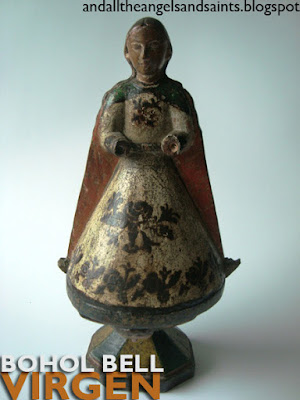Indeed, antique santos can come from the most unexpected places. The advent of the internet has changed the way we shop--antiques, included. Where before, sneaking out to the antique enclave of Manila from my Makati office meant braving jeepney rides and lunch-hour traffic just to check out new santo arrivals, now, santos are available on demand--thanks to good old ebay, rubylane, tias.com or etsy.
Suddenly, these online shops and auction sites provided a convenient and alternative way to acquiring santos. With just a click, you can be an armchair shopper and check on the antique through pictures provided by the dealer, and read through the descriptions, price points and shipping preferences. Sure there are risks involved in sourcing santos in this manner-- especially with international transactions--but by and large, my online buying experience has generally been pleasant.
Eventually, local selling sites like sulit.com.ph, buyandsellph.com started adding "antiques" as part of their product categories, and if one were patient enough to check the items regularly, one could spot a great santo find.
But what really made santo collecting more exciting was when social media sites became immensely popular. Facebook, for instance, attracted like-minded people who formed groups to share common interests. The sharing eventually progressed into buying and selling, and today, there are perhaps, more than a dozen facebook groups involved in the lively trade.
The santos featured here were all purchased online, from different sites. The deal is based on mutual trust, and I would like to think that the groups of which I am a member are strict in the enforcement of house rules, that mandates inclusion of a description and a price, plus a lot of caveats!
Negotiations and deals are sealed through private messaging and phone calls. Meet-ups and delivery by a courier are the most popular modes of transferring ownership of the item.You would agree that the santos that I have acquired online are a charming lot, with prices no different from antique shops, and in most cases, even cheaper. It takes a discerning eye and an inquisitive mind to spot a santo that's right for you and your budget, and a fast finger to click on the button to type in your final decision--MINE!
Suddenly, these online shops and auction sites provided a convenient and alternative way to acquiring santos. With just a click, you can be an armchair shopper and check on the antique through pictures provided by the dealer, and read through the descriptions, price points and shipping preferences. Sure there are risks involved in sourcing santos in this manner-- especially with international transactions--but by and large, my online buying experience has generally been pleasant.
Eventually, local selling sites like sulit.com.ph, buyandsellph.com started adding "antiques" as part of their product categories, and if one were patient enough to check the items regularly, one could spot a great santo find.
But what really made santo collecting more exciting was when social media sites became immensely popular. Facebook, for instance, attracted like-minded people who formed groups to share common interests. The sharing eventually progressed into buying and selling, and today, there are perhaps, more than a dozen facebook groups involved in the lively trade.
The santos featured here were all purchased online, from different sites. The deal is based on mutual trust, and I would like to think that the groups of which I am a member are strict in the enforcement of house rules, that mandates inclusion of a description and a price, plus a lot of caveats!
Negotiations and deals are sealed through private messaging and phone calls. Meet-ups and delivery by a courier are the most popular modes of transferring ownership of the item.You would agree that the santos that I have acquired online are a charming lot, with prices no different from antique shops, and in most cases, even cheaper. It takes a discerning eye and an inquisitive mind to spot a santo that's right for you and your budget, and a fast finger to click on the button to type in your final decision--MINE!















